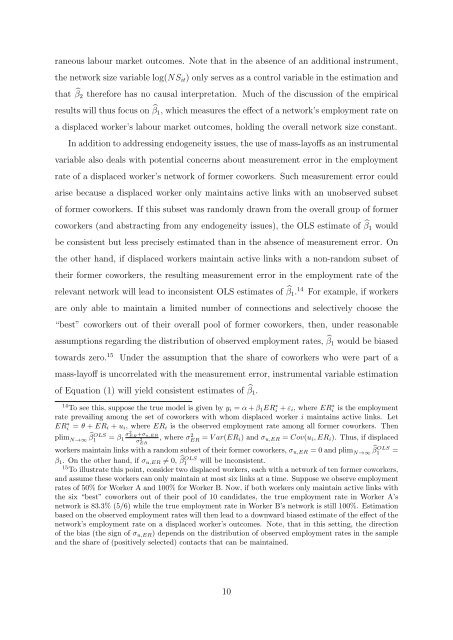paper - Universitat Pompeu Fabra
paper - Universitat Pompeu Fabra
paper - Universitat Pompeu Fabra
You also want an ePaper? Increase the reach of your titles
YUMPU automatically turns print PDFs into web optimized ePapers that Google loves.
aneous labour market outcomes. Note that in the absence of an additional instrument,<br />
the network size variable log(NS it ) only serves as a control variable in the estimation and<br />
that ̂β 2 therefore has no causal interpretation. Much of the discussion of the empirical<br />
results will thus focus on ̂β 1 , which measures the effect of a network’s employment rate on<br />
a displaced worker’s labour market outcomes, holding the overall network size constant.<br />
In addition to addressing endogeneity issues, the use of mass-layoffs as an instrumental<br />
variable also deals with potential concerns about measurement error in the employment<br />
rate of a displaced worker’s network of former coworkers. Such measurement error could<br />
arise because a displaced worker only maintains active links with an unobserved subset<br />
of former coworkers. If this subset was randomly drawn from the overall group of former<br />
coworkers (and abstracting from any endogeneity issues), the OLS estimate of ̂β 1 would<br />
be consistent but less precisely estimated than in the absence of measurement error. On<br />
the other hand, if displaced workers maintain active links with a non-random subset of<br />
their former coworkers, the resulting measurement error in the employment rate of the<br />
relevant network will lead to inconsistent OLS estimates of ̂β 1 . 14 For example, if workers<br />
are only able to maintain a limited number of connections and selectively choose the<br />
“best” coworkers out of their overall pool of former coworkers, then, under reasonable<br />
assumptions regarding the distribution of observed employment rates, ̂β 1 would be biased<br />
towards zero. 15<br />
Under the assumption that the share of coworkers who were part of a<br />
mass-layoff is uncorrelated with the measurement error, instrumental variable estimation<br />
of Equation (1) will yield consistent estimates of ̂β 1 .<br />
14 To see this, suppose the true model is given by y i = α + β 1 ERi ∗ + ε i, where ERi ∗ is the employment<br />
rate prevailing among the set of coworkers with whom displaced worker i maintains active links. Let<br />
ERi<br />
∗ = θ + ER i + u i , where ER i is the observed employment rate among all former coworkers. Then<br />
plim ̂βOLS σ<br />
N→∞ 1 = β 2 ER +σ u,ER<br />
1 , where σER 2 = V ar(ER i) and σ u,ER = Cov(u i , ER i ). Thus, if displaced<br />
σ 2 ER<br />
workers maintain links with a random subset of their former coworkers, σ u,ER = 0 and plim ̂βOLS<br />
N→∞ 1 =<br />
OLS<br />
β 1 . On the other hand, if σ u,ER ≠ 0, ̂β 1 will be inconsistent.<br />
15 To illustrate this point, consider two displaced workers, each with a network of ten former coworkers,<br />
and assume these workers can only maintain at most six links at a time. Suppose we observe employment<br />
rates of 50% for Worker A and 100% for Worker B. Now, if both workers only maintain active links with<br />
the six “best” coworkers out of their pool of 10 candidates, the true employment rate in Worker A’s<br />
network is 83.3% (5/6) while the true employment rate in Worker B’s network is still 100%. Estimation<br />
based on the observed employment rates will then lead to a downward biased estimate of the effect of the<br />
network’s employment rate on a displaced worker’s outcomes. Note, that in this setting, the direction<br />
of the bias (the sign of σ u,ER ) depends on the distribution of observed employment rates in the sample<br />
and the share of (positively selected) contacts that can be maintained.<br />
10
















